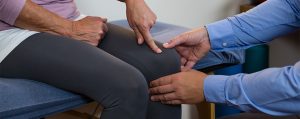Tips from a PT: Building Muscular Strength
Building strength and muscle mass is a goal that many have (and these two attributes will typically go hand-in-hand), whether the person wants to be healthier, look better, help improve athletic performance, etc. These people all have similar goals of improving as much as they can. With new information about the importance of muscle mass and strength for overall health, starting your strength and muscle gain journey as soon as possible is of high importance. But where to begin? How do you navigate the process? There are so many resources on muscle gain and strength building, and it is easy to get lost in the noise. This blog will lay out tips to help you along this journey and give you a framework to draw a plan.
Tips from a PT: How to Perfect the Squat
Squats are a foundational exercise movement. When you squat, you move at multiple joints via the action of several major muscle groups. A squat involves a hip hinge and bending at the knee and ankle. A squat is also a functional movement. Every time you sit down in a chair or get up from a seated position, you move through a squat pattern. Despite the familiarity of this movement pattern, it is easy to make errors with your squat form. So here are some tips to help you squat better (and maybe even with less pain or less risk of injury).
Returning to Workouts After an Illness
The response to flu, colds, or bronchitis is varied, and individuals may be affected differently. A cold can present varying symptoms and severity, including sore throat, coughing, sneezing, fatigue, fever, and more. How do you know when to return to your workouts after being sick? This blog will discuss a few physical therapist-approved tips to help you get back to your favorite activities.
3 Ways to Use a Foam Roller
Foam rollers are one of the most widely used tools in the fitness industry. Everywhere you look, you seem to see either someone using one or touting the benefits of one of them, but does the evidence support the use of these therapeutic devices? A casual look into the research shows some positive benefits of using a foam roller, and I will give a few of my favorite ways to use one for your next workout.
4 Back-to-School Posture Tips for Students
When the school supplies take over store aisles and the daylight hours begin to shorten, one can sense that back-to-school time is here. Be sure your return is pain-free! Here are four tips for decreasing strain on your spine and improving the ergonomics of your school experience. (more…)
4 Ways to Treat Tight Muscles
A common question we get as physical therapists is, “What can I do to stretch this tight muscle?” While stretching may seem like the best method to treat a tight muscle, stretching may also not always be the answer. Muscle tightness can be caused by weakness or tightness of the muscle, and weakness in surrounding muscles. Most commonly, all of these things are involved on some level, which causes a muscle to tighten.
The Importance of Muscle Hydration
Water is one of the essential nutrients we can consume and vital to every cell in our body. The human body is made up of 60% water, with muscles up to 79% water. As you can see, hydration is essential for the human body, muscles included. As such, it is necessary to maintain proper hydration for increased muscle function and response.
6 Exercises to Help Minimize an Injury to the ACL
With ACL injuries on the rise in young athletes, it is as important as ever to improve the strength in the lower limbs as a means to prevent an ACL tear.1 The average time of recovery after an ACL tear and subsequent surgery is typically six to nine months, and can set back an athlete for a much longer period of time than that.2 Biomechanics and strength are just a few pieces of the puzzle that can help prevent an injury. Proper rest, recovery, sleep, and nutrition can also help minimize the risk of an ACL tear from happening. The following are a list of strengthening exercises that address important aspects of an ACL prevention program.
